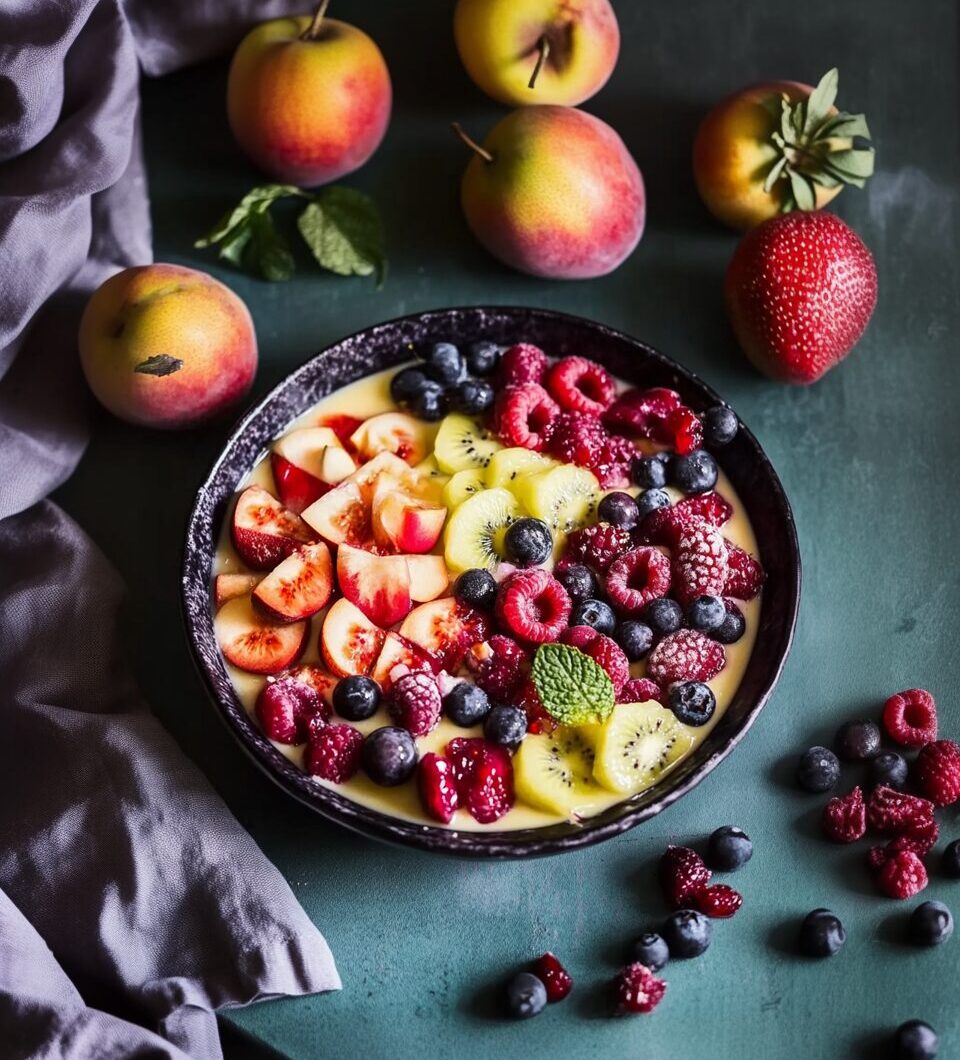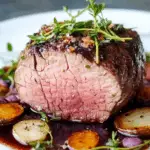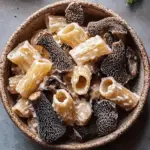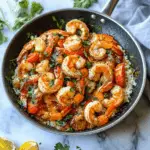Fruit Custard is a delightful Indian dessert that combines the creamy richness of eggless vanilla custard with a medley of fresh, seasonal fruits. This versatile and easy-to-make treat is perfect for warm days, offering a refreshing and lightly sweet option that’s both satisfying and visually appealing. Whether served at family gatherings or enjoyed as a simple homemade indulgence, Fruit Custard brings together the natural sweetness of fruits with the smooth texture of custard, making it a favorite across generations.
Full Recipe:
Ingredients
- 2 cups whole milk
- 2 tablespoons heavy cream (optional)
- 3 tablespoons custard powder or vanilla pudding mix
- 5 tablespoons sugar (adjust to taste)
- 2 cups assorted fruits (such as strawberries, kiwi, banana, pomegranate, mango, apple, grapes)
- ½ teaspoon ground green cardamom (optional)
- 1 teaspoon rosewater (optional)
- 5 strands saffron (optional)
Note: Avoid using citrus fruits, pineapples, or melons, as their acidity and water content can affect the custard’s texture and flavor.
Directions
- In a heavy-bottomed pot, bring the milk to a lukewarm temperature over medium to high heat. If using, add heavy cream, saffron strands, or ground cardamom before the milk reaches a boil.
- While the milk is warming, take three tablespoons of it and mix with the custard powder in a separate bowl, stirring until completely smooth and lump-free.
- Once the milk begins to boil, add the custard mixture and sugar, stirring continuously to ensure a smooth consistency. Boil for 2 minutes, then reduce the heat to a soft simmer for another 2-4 minutes, until the custard thickens enough to coat the back of a spoon.
- Remove the pot from heat and transfer the custard into a mixing bowl. Cover with cling wrap and chill in the refrigerator for at least 30 minutes.
- Just before serving, chop the assorted fruits into bite-sized pieces.
- After the custard has chilled, whisk it well to remove any lumps. Stir in the chopped fruits and, if desired, add rosewater.
- Serve chilled, garnished with additional chopped fruits on top.
Nutritional Facts (per serving)
- Calories: 244 kcal
- Carbohydrates: 47g
- Protein: 5g
- Fat: 5g
- Saturated Fat: 3g
- Cholesterol: 43mg
- Sodium: 84mg
- Potassium: 349mg
- Fiber: 2g
- Sugar: 34g
- Vitamin A: 580 IU
- Vitamin C: 3mg
- Calcium: 181mg
- Iron: 1mg
A Brief History of Fruit Custard
Custard as a dessert has been around for centuries and has evolved into various forms across different cultures. Its origins can be traced back to medieval England, where it was a basic mixture of eggs, milk, and sugar, often thickened with flour or cornstarch. Over time, custard became a popular dessert in many parts of the world, adapting to regional tastes and local ingredients.
Fruit Custard, in particular, has its roots in Indian culinary traditions. In India, it became a beloved dessert that was often prepared for special occasions and holidays. The use of fresh fruits such as mango, banana, and pomegranate, combined with a rich custard base, creates a dessert that is both indulgent and refreshing. While the base recipe for custard remains quite similar, the fruits added to the dish vary according to the season, making it a truly versatile dessert.
The Popularity of Fruit Custard in Indian Cuisine
Fruit Custard is widely adored across India for its simplicity and versatility. It is often served during festivals, weddings, and family celebrations, providing a cooling contrast to the often spicy and heavy meals typically consumed in Indian cuisine. The ability to customize the fruit selection according to what is in season makes it a year-round favorite.
The dessert is not just limited to special occasions but is also enjoyed as a quick and easy homemade treat. It is especially popular in homes with young children, as the soft, creamy texture and sweetness are highly appealing. Additionally, it offers a healthier alternative to other rich and calorie-laden desserts, making it a favorite among those looking for a lighter option.
Health Benefits of Fruit Custard
While Fruit Custard is undeniably delicious, it also offers a range of health benefits, thanks to its star ingredients: fruits and milk. Fresh fruits are packed with essential vitamins, minerals, and antioxidants that contribute to overall health and well-being. Some fruits commonly used in fruit custard, like mangoes, strawberries, and apples, are rich in Vitamin C, which helps boost immunity and promote skin health.
Milk, the base of the custard, is an excellent source of calcium, which is crucial for maintaining strong bones and teeth. It also provides protein and essential nutrients like Vitamin D, making it an important addition to a balanced diet. By combining fruits with milk and custard powder, you get a dessert that is not only tasty but also nutritionally beneficial.
One of the best aspects of Fruit Custard is its versatility, allowing you to use a variety of fruits depending on your dietary preferences or what is available in your area. For instance, mangoes are a popular choice in the summer, while apples and bananas are enjoyed in the winter. You can also add nuts and dry fruits like almonds and raisins to enhance the texture and provide additional nutritional value.
Customizing Your Fruit Custard
The beauty of Fruit Custard lies in its adaptability. While the basic recipe involves milk, custard powder, sugar, and fruits, there are numerous ways to make it unique to your taste.
One of the most exciting ways to customize your fruit custard is by adding different fruits according to the season. In the summer, you can use tropical fruits like mangoes, papayas, and pineapples, while the winter season might inspire you to use apples, pears, grapes, and berries. The fruit combinations are endless, and each variation offers a new and exciting flavor profile.
For those with a sweet tooth, you can always increase the sugar content or add condensed milk for extra sweetness. On the other hand, if you’re looking for a lighter version, you can reduce the sugar and even opt for low-fat milk to make the dessert less calorie-dense. For a more exotic flavor, you can add rosewater, cardamom, or saffron to infuse the custard with a delightful fragrance and richness.
Additionally, for a creamy and indulgent twist, you can incorporate whipped cream or yogurt into the dessert. Some variations even include the use of cream cheese to give the custard a richer texture and taste.
Fruit Custard as a Vegan Option
While the traditional recipe for Fruit Custard uses dairy ingredients, it is possible to make a vegan version that retains the same creamy texture and delicious taste. To make vegan fruit custard, you can substitute dairy milk with plant-based milk, such as almond milk, soy milk, or coconut milk. These alternatives provide a similar creamy consistency and work well with the custard powder.
You can also replace regular sugar with coconut sugar or maple syrup for a more natural sweetener. Vegan versions of whipped cream are also available, which can be added to the custard for an extra touch of creaminess. These adjustments allow you to enjoy a dairy-free version of Fruit Custard that is just as satisfying as the traditional recipe.
How to Serve Fruit Custard
Fruit Custard can be served in various ways, making it an ideal dessert for both casual and formal gatherings. It can be served in individual bowls, glasses, or jars for a more sophisticated presentation. For a larger gathering, you may choose to serve it in a large bowl and allow guests to scoop their portions.
Conclusion
Fruit Custard is a classic dessert that blends simplicity with richness, offering a delightful treat for any occasion. Its versatility in terms of fruit combinations and the ease with which it can be prepared makes it a go-to choice for many home cooks and professional chefs alike. Whether you’re serving it at a family dinner, a festive celebration, or just as a sweet snack, Fruit Custard is sure to please everyone at the table.






